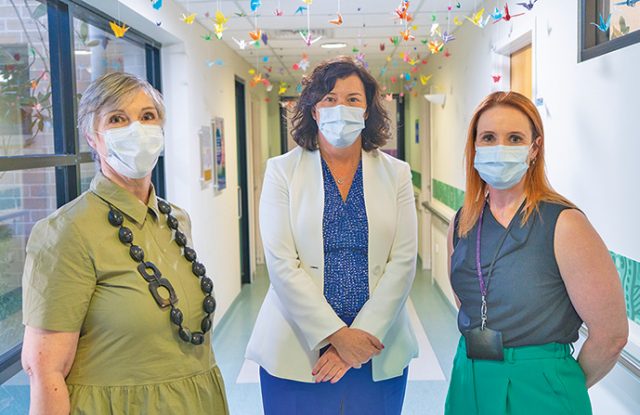A report has shown that an estimated 2,369 people in the Nepean Blue Mountains Local Health District (NBMLHD) will be told they have cancer this year, and 713 people will lose their lives to the disease in 2022.
Last week, Chief Cancer Officer for NSW and Cancer Institute NSW CEO, Professor Tracey O’Brien visited Nepean Hospital to discuss how the Institute can help lessen the impacts of cancer for locals.
The snapshot report compiled by the Institute shows that the most common cancers to be diagnosed in NBMLHD in 2022 are breast cancer with 303 cases, followed by bowel cancer, melanoma, and non-Hodgkin’s lymphoma.
The most common cause of cancer death in the area this year is lung cancer with 135 deaths, along with bowel, pancreatic, breast and prostate cancers.
“NSW is recognised as a global leader in cancer care, with survival rates among the best in the world, but there is still much more we can do to lessen the impact of cancer,” Professor O’Brien said.
“Cancer continues to impact too many people in our community with one in two people in NSW diagnosed in their lifetime.”
With one in three cancers being prevented through healthy living, limiting alcohol, maintaining a healthy weight, and eating healthy is being promoted to everyone in the area.
Being active, protecting your skin and quitting smoking is also highlighted to reduce the risk of developing common types of cancer.
A highly respected paediatric oncologist and haematologist, Professor O’Brien met with NBMLHD Chief Executive Kay Hyman as well as senior staff from the District to discuss local cancer treatments, patient care and support, as well as cancer prevention and screening programs.
“Our reporting has highlighted improvements across several areas of cancer control in NSW,” she said.
“For instance, the number of eligible people taking part in breast, cervical and bowel cancer screening continues to increase.”
12 per cent of adults in the region are reported as daily smokers compared to the state average of 8.2 per cent.
Only 35.5 per cent of adults in NBMLHD are classed as a healthy body weight compared to 43.2 per cent for NSW.
While there have been improvements, Professor O’Brien said there are also opportunities for further advancements, such as the smoking rate.
Only 40.2 per cent of cancers in NBMLHD are diagnosed while they are still in the early stages, allowing them to be treated more successfully with better outcomes for the patient.
“We want to see fewer Nepean Blue Mountains residents diagnosed with cancer and increase survival and improve quality of life for people who do experience the disease,” she said.
“We will continue to collect and analyse data that supports NBMLHD to deliver excellent outcomes for people affected by cancer.”
Emily Feszczuk
A graduate of Western Sydney University, Emily covers Local, State and Federal politics for the Weekender, as well as crime and general news.

